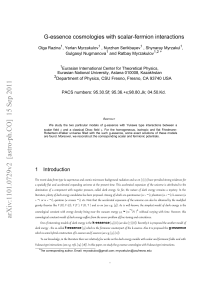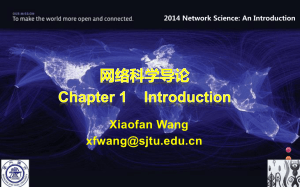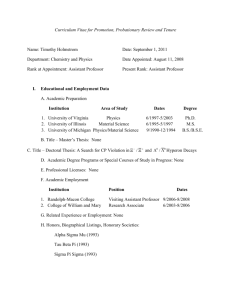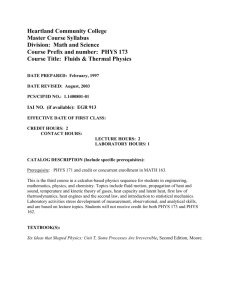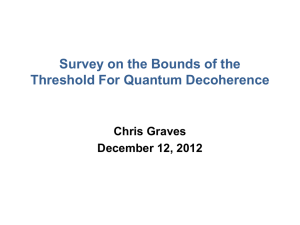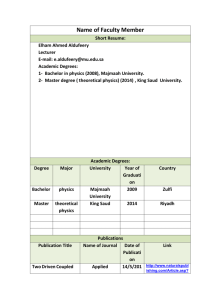11 (1)
advertisement
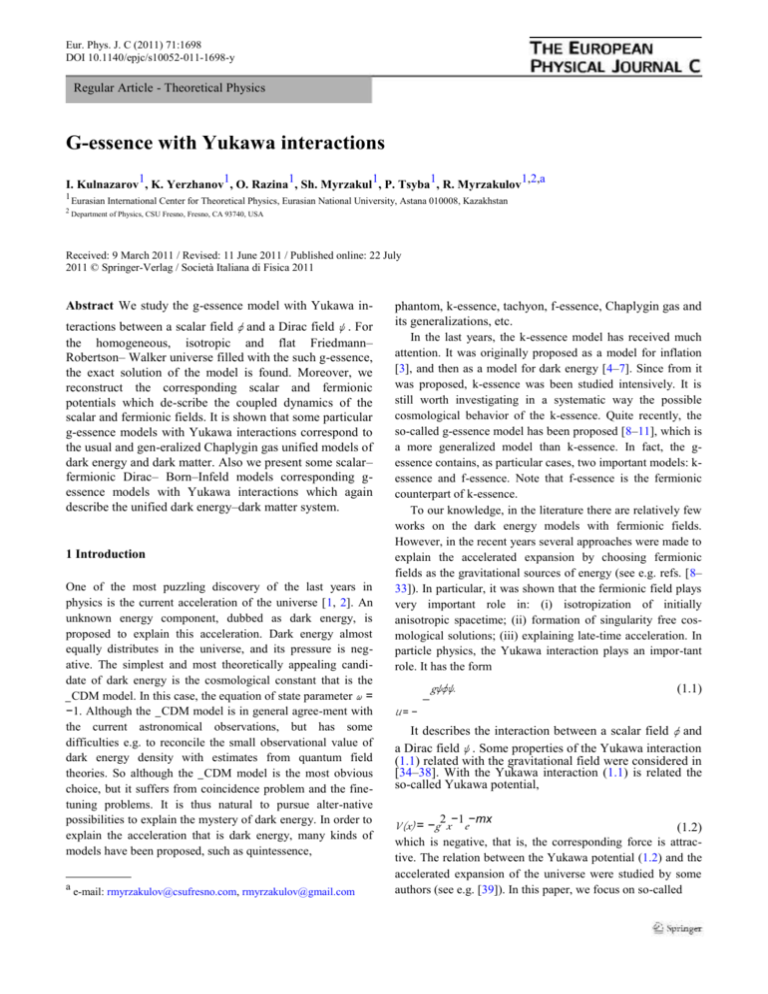
Eur. Phys. J. C (2011) 71:1698 DOI 10.1140/epjc/s10052-011-1698-y Regular Article - Theoretical Physics G-essence with Yukawa interactions 1 1 1 1 1 1,2,a I. Kulnazarov , K. Yerzhanov , O. Razina , Sh. Myrzakul , P. Tsyba , R. Myrzakulov 1 2 Eurasian International Center for Theoretical Physics, Eurasian National University, Astana 010008, Kazakhstan Department of Physics, CSU Fresno, Fresno, CA 93740, USA Received: 9 March 2011 / Revised: 11 June 2011 / Published online: 22 July 2011 © Springer-Verlag / Società Italiana di Fisica 2011 Abstract We study the g-essence model with Yukawa interactions between a scalar field φ and a Dirac field ψ . For the homogeneous, isotropic and flat Friedmann– Robertson– Walker universe filled with the such g-essence, the exact solution of the model is found. Moreover, we reconstruct the corresponding scalar and fermionic potentials which de-scribe the coupled dynamics of the scalar and fermionic fields. It is shown that some particular g-essence models with Yukawa interactions correspond to the usual and gen-eralized Chaplygin gas unified models of dark energy and dark matter. Also we present some scalar– fermionic Dirac– Born–Infeld models corresponding gessence models with Yukawa interactions which again describe the unified dark energy–dark matter system. 1 Introduction One of the most puzzling discovery of the last years in physics is the current acceleration of the universe [1, 2]. An unknown energy component, dubbed as dark energy, is proposed to explain this acceleration. Dark energy almost equally distributes in the universe, and its pressure is negative. The simplest and most theoretically appealing candidate of dark energy is the cosmological constant that is the _CDM model. In this case, the equation of state parameter ω = −1. Although the _CDM model is in general agree-ment with the current astronomical observations, but has some difficulties e.g. to reconcile the small observational value of dark energy density with estimates from quantum field theories. So although the _CDM model is the most obvious choice, but it suffers from coincidence problem and the finetuning problems. It is thus natural to pursue alter-native possibilities to explain the mystery of dark energy. In order to explain the acceleration that is dark energy, many kinds of models have been proposed, such as quintessence, a e-mail: rmyrzakulov@csufresno.com, rmyrzakulov@gmail.com phantom, k-essence, tachyon, f-essence, Chaplygin gas and its generalizations, etc. In the last years, the k-essence model has received much attention. It was originally proposed as a model for inflation [3], and then as a model for dark energy [4–7]. Since from it was proposed, k-essence was been studied intensively. It is still worth investigating in a systematic way the possible cosmological behavior of the k-essence. Quite recently, the so-called g-essence model has been proposed [8–11], which is a more generalized model than k-essence. In fact, the gessence contains, as particular cases, two important models: kessence and f-essence. Note that f-essence is the fermionic counterpart of k-essence. To our knowledge, in the literature there are relatively few works on the dark energy models with fermionic fields. However, in the recent years several approaches were made to explain the accelerated expansion by choosing fermionic fields as the gravitational sources of energy (see e.g. refs. [8– 33]). In particular, it was shown that the fermionic field plays very important role in: (i) isotropization of initially anisotropic spacetime; (ii) formation of singularity free cosmological solutions; (iii) explaining late-time acceleration. In particle physics, the Yukawa interaction plays an impor-tant role. It has the form gψφψ. U= − (1.1) ¯ It describes the interaction between a scalar field φ and a Dirac field ψ . Some properties of the Yukawa interaction (1.1) related with the gravitational field were considered in [34–38]. With the Yukawa interaction (1.1) is related the so-called Yukawa potential, 2 −1 −mx V (x) = −g x e (1.2) which is negative, that is, the corresponding force is attractive. The relation between the Yukawa potential (1.2) and the accelerated expansion of the universe were studied by some authors (see e.g. [39]). In this paper, we focus on so-called Page 2 of 9 Eur. Phys. J. C (2011) 71:1698 g-essence model [8–11] which is some hybrid construction of k-essence and f-essence. If exactly, we will consider the g-essence with the Yukawa interaction (1.1). The formulation of the gravity-fermionic theory has been discussed in detail elsewhere [40–44], so we will only present the result here. This paper is organized as follows. In the following section, we briefly review g-essence. In Sect. 3, we introduce the g-essence model with the Yukawa interaction. In Sect. 4, we construct the solution of the particular g-essence model with the scalar–fermionic Yukawa interaction. The unified scalar–fermionic Chaplygin gas model of dark energy and dark matter from the g-essence model with the Yukawa in-teraction were constructed in Sect. 5 and its extension for the generalized Chaplygin gas case in Sect. 6. The scalar– fermionic Dirac–Born–Infeld (DBI) counterpart of the g-essence model with the Yukawa interaction (3.1) was con-structed in Sect. 7. Finally, we shall close with a few con-cluding remarks in Sect. 8. The metric signature used is (+, −, −, −) and units have been We now consider the dynamics of the homogeneous, isotro-pic and flat FRW universe filled with g-essence. In this case, the background line element reads 2 ds = dt 2 − a2 dx2 + dy2 + dz2 and the vierbein is chosen to be μ ea = diag(1, 1/a, 1/a, 1/a), H ˙ 2 +3 φ KX ¨ + K Y d 4x√ (2.1) ψ) , −g R + 2K(X, Y, φ, ψ, ¯ where K is the g-essence Lagrangian and is some func-tion of its arguments, φ is a scalar function, ψ = (ψ1, ψ2, T ψ3, ψ4) is a fermionic function and ψ ¯ = ψ +γ 0 is its ad- joint function, the curvature scalar R. Here δ √ ψ)Γ μ ¯ −g = −0.5gμν √ μν −gδg , μν δK __ K δφ K K δψ = + √1 − g ∂ μ( + −g∂μφ). +˙ iγ 0K ψ ¯ 0 , (2.12) 0, (2.13) = iK γ 0 K )ψ Y 53 + ¯ Y ψ = + (2.14) and denotes the Hubble = dK/d =˙ parameter, the dot represents a differentiation with respect to time t . Here the kinetic terms, the energy density and the pressure take the form X 0.5φ2, Y 0.5i ψγ 0ψ ψγ 0ψ (2.15) ˙ dK/dψ , K ψ Ha/a ¯ ψ ¯ ˙ = ˙ − ¯ ρ = 2KX X + KY Y − K, ¯ ___δψ, 2 3H − ρ = 0, H 2 ˙ +3 3 p + 3 (2.16) (2.17) (2.18) 0, = (2.19) (2.20) − a Kφ = 0, t 3 a3KY ψ (2.6) H2 φ (2.4) (2.5) ¯ p = K. Note that the equations of g-essence (2.9)–(2.14) can be rewritten as a KY ψj d’Alembertian on a scalar φ is φ= − =0 where KX = dK/dX, KY = dK/dY , Kφ = dK/dφ, Kψ = (2.3) σ where ∇ν Vμ ≡ ∂ν Vμ − Γμν Vσ is the covariant derivative of a vector Vμ and the curved √ 0. ( H K ˙ a KX ˙ δR = (Rμν + gμν − ∇μ∇ν )δg , _ ˙Y + (2.11) , φ K )ψ Y ˙ ψ K ˙− + 3H KX ) (2.2) μ Dμψ − (Dμ ¯ ψ are the canonical kinetic terms for the scalar and fermionic fields, respectively. ∇μ and Dμ are the covariant derivatives. The fermionic fields are treated here as classically commuting fields. The model (2.1) admits important two reductions: k-essence and f-essence. In this sense, it is the more general essence model and in [8–11] it was called g-essence. Note that to find the equations of motion we need the variations Y = 0.5i = φ ˙ = and μν X = 0.5g ∇μφ∇ν φ, ψΓ + (K ψ 0.5(3H K ¯ (2.9) (2.10) 0, p ρ˙ + 3H (ρ + p) = 0, The action of g-essence has the form [8–11] = H2 X Y S (2.8) 2 3H − ρ = 0, K 2 Basics of g-essence a eμ = diag(1, a, a, a). In the case of the FRW metric (2.7), the equations corre-sponding to the action (2.1) look like [8–11] + chosen so that 8π G = c = = 1. (2.7) 2 2iKψ t− ∗2 j t 0 γ ψ 2iKψ + j= ¯ 0, 0, ψγ0 ¯ j (2.21) = ρ˙ + 3H (ρ + p) = 0. (2.22) Also we present the useful formula Y0.5iK K Y = 0 ψγ ψ Y ¯ 0 ψγ ψ ˙ ˙ − 0.5(Kψ ψ =− ¯ ψ) + ¯ (2.23) Eur. Phys. J. C (2011) 71:1698 and the equation for u = ln ua3K t Y Page 3 of 9 ψψ ¯ : iK −1 u Y ¯ ψγ 0K K γ0 ψ ψ ψ. (2.24) =− ¯− Finally, we note that some exact solutions of g-essence (2.9)–(2.14) were presented in [15]. As is well known, the energy-momentum tensor for the kessence field has the form Tμν = KX ∇μφ∇ν φ − gμν K = 2KX Xu1μu1ν − Kgμν = (ρk + pk )u1μu1ν − pk gμν . 2.1 Purely kinetic g-essence Let us consider the purely kinetic g-essence , that is, when K = K(X, Y ). In this case, the system (2.9)–(2.14) becomes 2 3H − ρ = 0, 2 a H2 H 3 + p = 0, ˙+3 φ σ ˙− KX 3 2 3 ∗2 (2.25) (2.26) (2.27) , =0 a KY ψj − ςj = 0, (2.28) ∗ − ςj = 0 , (2.29) ρ˙ + 3H (ρ + p) = 0, (2.30) a KY ψj where σ (ς ) is the real (complex) constant. Hence we immediately get the solutions of the Klein–Gordon and Dirac equations, respectively, as (2.39) It is interesting to note that in the case of the FRW metric (2.7), purely kinetic k-essence and F(T)-gravity (modified teleparallel gravity) are equivalent to each other, if φ−φ0 ±√ 12 [45, 46]. 2.3 F-essence a=e Now we consider the following reduction of g-essence (2.1): (2.40) = 2 = K2(Y, ψ, that is, f-essence [8–11]. The energy-momentum tensor for the f-essence field has the form δS 2 K K ψ) ¯ −g Tμν ≡ √ δgμν ψΓ = 0.5iKY ¯ ψΓ ¯ (μDν)ψ − D(μ − gμν K ψ ν) = KY Y u2μu2ν − Kgμν ς dt φ= a3KX σ , j a3KY ψj = (2.31) . Also the following useful formula holds: 2 0.5σ σ X= 6 2 or KX = a √ . 3 2X a K (2.32) = (ρf + pf )u2μu2ν − pf gμν . (2.41) For the FRW metric (2.7), the equations of the f-essence be-come [8–11] 2 3H − ρf = 0, H X 2.2 K-essence K2Y ˙ H 2 ˙ 2 +3 ψ 0.5(3H K + p f= 2Y K 2Y ˙ + Let us now we consider the following particular case of gessence (2.1): )ψ 53 2Y K2Y )ψ + ˙ ¯+ ¯+ 0 0K 2ψ iγ − + 0 . ( HK ψ K2Y ˙ (2.42) (2.43) 0, iK2ψ γ , (2.44) 0, (2.45) = ¯ 0 = ρ˙f + 3H (ρf + pf ) = 0, (2.46) where K = K1 = K1(X, φ) (2.33) that corresponds to k-essence. Then the system (2.9)–(2.14) takes the form of the equations of k-essence (see e.g. [3–6]) 3H − ρk = 0, ˙ 2 +3 K H 2 φ 1X pf = K2. (2.47) 3 Model 2 H ρf = K2Y Y − K2, ¨+ (2.34) + pk = 0 , (K ˙ 1X + 3H K1X ) ˙ ρ˙k + 3H (ρk + pk ) = 0, φ − K 1φ = 0 , (2.35) (2.36) (2.37) where the energy density and the pressure are given by ρk = 2K1X X − K1,pk = K1. (2.38) In this section, we consider the action (2.1) with the follow-ing particular g-essence Lagrangian: n K = α1X + α2X + α3V1(φ) + β1Y (ψ, ψ) m + β2Y + β3V2 ¯ ηU + 1 2 ¯ (φ)U (ψ, ψ),(3.1) where αj , βj , η are some real constants. As the search for exact solutions of the coupled system of differential equa-tions (2.9)– (2.14) for the g-essence Lagrangian (3.1) is a Page 4 of 9 Eur. Phys. J. C (2011) 71:1698 very hard job, let us simplify the problem e.g. as V2 = V2(u), β2 = 0, U1 = φ, U2 = u. Then the system (2.9)–(2.14) takes the form 2 2 3H − ρ = 0, 2 H 3 ˙+ H2 p + 3H φ = ln α1 + ¨+ (3.2) (3.3) 0, + α2nX α1 + α2nX n−1 − ˙ + 1 . Hψ ψ 5 ˙ ¯ 21−nα2nδ2nφ2n φ 2λ (3.4) − ¯ + (3λ u V (β 1 iβ 1− 1 (β3V2uψ ψ + 2u 3 ηφψ) 0 ηφψ)γ + = ¯ ¯+ 0, (3.5) 0, (3.6) = ρ˙ + 3H (ρ + p) = 0, (3.7) n ρ = α1X + α2(2n − 1)X − α3V1 − β3V2 − ηφu, (3.8) n p = α1X + α2X + α3V1 + β1Y + β3V2 + ηφu. (3.9) + p 2α = β1Y = − β3V2 1 + 2α2nX _ H, n + β1Y = −2 (4.8) or δ = 3λ − 2n 1 . (4.9) 2n − The corresponding potentials take the form 2(δ−1) φ (3.10) ˙ V1(φ) = l1 2n(δ−1) φ δ + l2 φ0 (3.11) + ηφ u, (4.7) + D0. This solution is correct if Hence and from (2.23)–(2.24) we get ρ 3λ−1 δ = 2 − 3λ where X t 1) − 0 0 t 2n(δ−1)+3λ+1 + u0[2n(δ − 1) + 3λ + 1] = iβ −1γ t 2(δ−1)+3λ+1 β1u0[2(δ − 1) + 3λ + 1] 0 0, 1.5H ψ ψ n−1 D= t ˙ α3V1φ + ηu − and δ φ0 δ−3λ φ δ (4.10) c u= β1a 3 + l3 (3.12) . + V10, φ0 2(1−δ) 4 Solution V2(u) = q1 2n(1−δ) 3λ u 3λ u + q2 u0 u0 2 3λ−δ In this section, we want to present the exact solution of the system (3.2)–(3.7). But first note that for six unknown func- u tions we have five differential equations a, φ, ψ, ψ, V1 2 a = a¯0φ , where a a φ −k , ¯0 = ing solution: 0 k = 0 (4.1) λ/δ. Then we obtain the follow- λ a = a0t , (4.2) δ cl a1.5t 1.5λ c k 0 a1.5t 1.5λ e−iD , (l = 1, 2), (4.4) iD e , (k = 3, 4), (4.5) l1 = 2 (4.11) 10 2 2 2 ηδφ0u0 l3 = − (4.13) , (4.14) α3(δ − 3λ) and 2 2 q1 = 0.5α1δ φ0 − α3l1, q4 = −3λ2. (4.6) (4.12) n 2 α3(δ − 1) l2 = −n 2 n 2 n c = |c1| + |c2| − |c3| − |c4| −3 −1 β1 , 2α3(δ − 1) , 2n 2n α2δ φ0 [(2n − 1)(δ − 1) + 3λ] q2 = α2(2n − 1)2 δ φ0 −α3l3 − ηφ0u0, where cj obey the condition 0 α1δ2φ02(δ − 1 + 3λ) (4.3) φ = φ0t , ψk = 3 3 Here V10 = const, u0 = ca0 k 0 + q4 0 3λ u α β−1V . − (3.2)–(3.6) so that we need one more equation (see e.g. [47– 49]). Such an equation we take to be ψl = u + q3 ,V ¯ u 3λ (4.15) − α3l2, q3 = (4.16) (4.17) (4.18) Eur. Phys. J. C (2011) 71:1698 Page 5 of 9 (2.14), we get 5 Unified scalar–fermionic Chaplygin gas model of dark energy and dark matter from gessence with Yukawa interactions 0.5 ρ=a The most popular models of dark energy and dark matter such as e.g. the _CDM and a quintesse-CDM model assume that dark energy and dark matter are distinct entities. An-other interpretation of the observational data is that dark en-ergy and dark matter are different manifestations of a com-mon structure. The first definite model of this type was pro-posed in [50, 51], based upon the Chaplygin gas, an exotic perfect fluid obeying the equation of state (EoS) −3 2 6 0.5 2 = z−0.5 p= − ρ, 6 where C = const, z = a . From these formulas we obtain the following expression for the EoS parameter: U 2 2 z d ln ρ ω = − ρ2 = −1 − d ln ρ2 dz =− d ln z zU 2 U2 C = −C zh (z) dz + _ (5.1) which has been extensively studied for its mathematical properties [52]. The general class of models, in which a uni-fication of dark energy and dark matter is achieved through a single entity, is often referred to as quartessence. Among other scenarios of unification that have recently been sug-gested, interesting attempts are based on kessence. In this section we extend this scenario to the gessence model with Yukawa interactions which gives us the Chaplygin gas uni-fied model of dark energy and dark matter. To do it, let us consider the g-essence model given by the following scalar– fermionic DBI Lagrangian: (5.7) C + U (z) dz, = −1 − A 5 U (a)a da + C _ = −z ln(C + h) , (5.8) + _ 2 where h = U (z) dz, h = dh/dz. In principle, now it is not difficult to construct solutions of the g-essence equa-tions corresponding to the different expressions for U . Here we just present the expressions for the energy density and pressure. Consider some examples. (i) Let U = μ = const. Then from (5.7) and (5.6) we obtain the expressions for the energy density and the pressure ρ = z−0.5 h C + μ2z 0.5 = Ca−6 + μ2 (5.9) 0.5 and 2 1 + V1 X + V2 Y , where in general U = U (φ, ψ, ψ), V K=U V ¯ ψ, ψ) 1 = V1(φ, (5.2) ψ, ψ) V , ¯ 2 . Note that the g-essence model (5.2) is con2 strained in two particular cases: (i) the scalar DBI model as U = U (φ), V1 = V1(φ), V2 = 0; (ii) the fermionic DBI ¯ = . Substitut¯ 1 = 0, V2 = V2 ing the expression (5.2) into (2.16) we get model as U U (ψ, ψ), V p= − μ2 1 + V1 X + V2 Y where we assume that U ηφu, 1 = V1(φ, , = V2(φ, (5.5) ¯ Yukawa interactions μ2z2ν+1 ω= − μ2 0.5 −3 ρ≈C 2ν+1 z a ,p ≈ 0 1 2ν . (5.11) + (5.6) It is the Chaplygin gas model [50, 51] but with the variable function U (Yukawa interactions). From (5.6) and (5.12) with ω = 0, which corresponds to a matter-dominated uni-verse. For a large value a, it follows that ρ ≈ μ,p ≈ −μ U2 . (5.10) + the energy density and the pressure take the forms, U = ηφu. These equations give the following EoS: ρ , (5.4) ψ, ψ), ¯ It is the g-essence model with p= − μ2)0.5 So this example corresponds to the usual Chaplygin gas [50, 6 −0.5 51]. As is well known, in this case, for small a (a _ Cμ ), ψ, ψ). 2 6 approximately, V = V 2 (Ca (5.3) U ρ= − =− μ 2ν+1 z + − ) respectively. The EoS parameter is given by C+ p = U 1 + V1X + V2Y , 1 0.5 (C + (ψ, ψ) 2 2ν = (φ, ¯ 2 μ2z2ν+0.5 (5.13) that is, ω = −1, which corresponds to a dark energydominated universe. So this simple and elegant model smoothly interpolates between a dust dominated phase, 0.5 −3 where ρ ≈ C a , and a de Sitter phase, where p ≈ −ρ, Page 6 of 9 Eur. Phys. J. C (2011) 71:1698 through an intermediate regime described by the EoS for stiff matter, p = ρ. ν (ii) Now let us consider the case when U = μz , where μ and ν are some real constants. In this case, (5.7) gives the following expression for the energy density: μ C+ ρ = z−0.5 = Ca −6 2ν 2 + 0.5 1 z2ν+1 1 0.5 μ2 + 2ν + 1 a12ν (5.14) . Here ν must be negative, because otherwise, a → ∞ im-plies ρ → ∞, which is not the case for expanding Universe. Equation (5.6) gives the expression for the pressure, μ2z2ν+0.5 p= − 2ν μ2 (C + 2ν+1 1 0. 5 + z μ2a12ν =− 6 − (Ca ) 12ν 0.5 μ2 μ2z2ν+1 C+ 1 2ν μ2 2ν+1 Ca − 6(1 + 2ν+1 a ) q =− ¨ aH 2 = (5.15) V (6.1) ψ, ψ), V (6.2) ¯ 1 = V1(φ, ψ, ψ). 1 p = U 1 + V1 X 2n 1 + V2Y 1 2n 1 ( U) n n , (6.3) 1 n−1 + V2Y n ( U) 1−n − p= − + 2ν+1 a n α+1 A − =− n 1 (6.4) . ρ =− α ρ α (6.5) , ρ − (5.16) + 3p Ca −6 + = 2ρ 2μ2(3ν+2) a12ν 2ν+1 6 μ2 2μ2(3ν + 2) C(2ν −6(2ν+1) . α+1 −1 where α = n(1 − n) , A = (−U ) . It is the scalar– fermionic generalized Chaplygin gas model [50, 51]. From (2.16) and (6.5) we get 1 . (5.17) ρ (5.19) 1) + 6 Unified scalar–fermionic generalized Chaplygin gas model of dark energy and dark matter from gessence with Yukawa interactions In the previous section we constructed the unified scalar– fermionic Chaplygin gas model of dark energy and dark a−3 3(1 − + 1+α C α)( U )α+1a3(1+α)−1 da = 12ν 1 a = c=− ηφu, = 12ν μ2 − 2(Ca + 2ν+1 a ) For accelerating universe, q must be negative i.e., a¨ > 0. Hence we have 2 2μ (3ν + 2) . a−6(2ν+1) < (5.18) − C(2ν 1) + This means that for a small value of the scale factor we have a decelerating universe while for large values of scale fac-tor we have an accelerating universe. The transition between these two phases occurs when the scale factor is equal to a U μ2a12ν 6 . μ2 2ν) ρ , where . + 2ν+1 + The deceleration parameter q has the expression a n These equations give Ca μ2 =− + V2 Y 2n ρ = −U 1 + V1X =− − + z K = U 1 + V1X 1 n 2 = V2(φ, ¯ Substituting this expression into (2.16) we get The EoS parameter is given by ω= − matter using the particular g-essence with Yukawa interactions having the scalar–fermionic DBI Lagrangian form (5.2). In this section we extend these results of the previous section for the scalar–fermionic generalized Chaplygin gas case. For this purpose, we consider the particular g-essence model with Yukawa interactions which has the following scalar–fermionic DBI Lagrangian form + 1 1 =z − (−U ) C+ 1+α α+1 dz 1+α (6.6) , 3(1+α) where C = const, z = a . At the same time, for the pressure we obtain the following expression −1 α p ( U )α+1z 1+α C ( U )α+1 dz α α + . (6.7) = −− + − These formulas give the following expression for the EoS parameter: α+1 z( U ) − ω =− ( C α U) . 1 (6.8) dz + − + Now we can consider different types solutions of the gessence equations. For example, if for simplicity, we consider the case ω = const then from (6.8) we obtain the following expression for the function U : 1 U =− A 1+α 0 a−3(1+ω), (6.9) Eur. Phys. J. C (2011) 71:1698 Page 7 of 9 where A0 is an integration constant. Let us consider some examples: (i) if ω = −1 (the de Sitter case) then U = 1 −A0 1+α ; (ii) if ω = 0 (the dust case) then U = −A0 1+α 1 −3 a ; 1 −6 (iii) if ω = 1 (the stiff matter case) then U = −A0 a and so on. Now the construction of solutions of the Friedmann, Klein–Gordon and Dirac equations is a formal problem so we omit it here. 1 +α 7 Scalar–fermionic DBI generalization of the gessence model with Yukawa interaction (3.1) Our aim in this section is to construct the scalar–fermionic DBI generalization of the g-essence model with Yukawa in-teraction (3.1). To do it, we note that the model (3.1) is some approximation of the following scalar–fermionic DBI model: −1 n K = _A 1 + A −1 2 α1 X + 2 α2 X + 2 β1 Y + 2 β2 Y 2 A p= − −1 p = _A 1 + A −1 ρ = + 2 which corresponds to the Chaplygin gas case [50, 51]. Now let us consider the second approximation. Then from (7.9) we obtain ¯ n − 2 2α1X m 2β1Y n [ + + 2β2Y ρ _A = Λg + (_A − 2α1X + 2β2Y 2 −1 _A A−1 2α1X 1 + + V, + _A − V 2β2Y 2 + [ + which corresponds to the EoS A2 p=− ] 2 _A − V A ρ(ρ − V)− _A + (7.5) (7.6) (7.7) − _A + V . =− − ρ _A + V (7.11) V. + second case when ρ _ ρ 2 + − A ≈ V V )2 _A − V 1+ ρ _A − ρ, V − _A + V (7.12) where ] ρ − _A + V The corresponding EoS parameter is given by ω _A − V + _A 2 A2 m (7.4) The study the system of equations of g-essence (2.9)– (2.14) with the expressions for the pressure and the energy density given by (7.3)–(7.4) is a very hard job. Let us simplify the problem. Let α2 = β1 = 0 and m = 2. Then (7.3)–(7.4) take the form 1+A A2(_A − V ) A + _A − V . p = _A ρ= − 1 ρ =− ρ − − (ii) Now let us consider the p= − − _A 2α2X −1 + ≈− V ρ (7.3) n 2_α2(n − 1)X − _β1Y + _β2(m − 2)Y + _A =−ρ A 2 m + V, A−1 2 A _A − V . Then from (7.7) we get 2 α1 X + 2 α2 X + 2 β1 Y + 2 β2 Y 1 (7.10) 2 (φ)U (ψ, ψ).(7.2) 1 − _A + V ρ p ηU ¯ _A ρ − A (ψ, ψ) ρ − ρ Hence, in the first approximation, we get (7.1) α V m + V, = 3V1(φ) + β3V2 From (7.1) we get 1 − . (7.8) V − − + Now let us consider two particular limit cases when ρ _ _A − V or ρ _ _A − V . (i) First we consider the case when ρ _ _A − V . Let us rewrite (5.7) as 2 A 1 − _A + V . p= − ρ (7.9) 1 _A V =_A where _ = +1, A = const and V 1 A2 2 A V − _A + V . − In this case, the EoS parameter is given by 2 (7.13) ω= (7.14) Λg = _A A (_A − Λg V )2 + ρ . 8 Conclusion Recently, the so-called g-essence has been proposed to be a candidate of dark energy. It has the non-standard kinetic scalar and fermionic terms and has interesting properties. We expect that g-essence has rich properties and when it is used in cosmology, its rich properties could have some interesting consequences. In this work, we found the exact power law solution of the particular g-essence model with the Yukawa scalar–fermionic interactions. The correspond-ing scalar and fermionic potentials are presented. Of course, Page 8 of 9 there might be other exact solutions of the g-essence different from the power law solution. Anyway, our results obtained in the present work showed that the g-essence with the Yukawa interactions can describes the accelerated expansions of the universe. In fact, we have shown that some particular g-essence models with Yukawa interactions correspond to the usual and generalized Chaplygin gas unified models of dark energy and dark matter. Also we presented some scalar–fermionic DBI models which again can describe the unified dark energy–dark matter system. Acknowledgements We would like to thank the anonymous refer-ees for providing us with constructive comments and suggestions to improve this work. References 1. S. Perlmutter et al., Measurements of omega and lambda from 42 high-redshift supernovae. Astrophys. J. 517, 565–586 (1999). arXiv:astro-ph/9812133 2. Riess et al., Observational evidence from supernovae for an accelerating universe and a cosmological constant. Astron. J. 116, 1009–1038 (1998). arXiv:astro-ph/9805201 3. C. Armendariz-Picon, T. Damour, V.F. Mukhanov, k-inflation. Phys. Lett. B 458, 209–218 (1999). arXiv:hep-th/9904075 4. C. Armendariz-Picon, V.F. Mukhanov, P.J. Steinhardt, Essentials of k-essence. Phys. Rev. D 63, 103510 (2001). arXiv:astro-ph/ 0006373 5. C. Armendariz-Picon, V.F. Mukhanov, P.J. Steinhardt, A dynami-cal solution to the problem of a small cosmological constant and late-time cosmic acceleration. Phys. Rev. Lett. 85, 4438–4441 (2000). arXiv:astro-ph/0004134 6. T. Chiba, T. Okabe, M. Yamaguchi, Kinetically driven quintessence. Phys. Rev. D 62, 023511 (2000). arXiv:astro-ph/9912463 7. R. De Putter, E.V. Linder, Kinetic k-essence and quintessence. As-tropart. Phys. 28, 263–272 (2007). arXiv:0705.0400 8. R. Myrzakulov, Fermionic k-essence. arXiv:1011.4337v5 9. K. Esmakhanova, N. Myrzakulov, G. Nugmanova, L. Chechin, R. Myrzakulov, Integrable and nonintegrable FRW cosmological models induced by some second-order ordinary differential equations. arXiv:1104.3705 10. G.N. Nugmanova, Sh.R. Myrzakul, O.V. Razina, K.R. Esmakhanova, N.S. Serikbayev, R. Myrzakulov, Some cosmological aspects of Horava-Lifshitz gravity: integrable and nonintegrable models. arXiv:1104.5374 11. Sh. Myrzakul, K. Esmakhanova, K. Myrzakulov, G. Nugmanova, R. Myrzakulov, FRW cosmological models with integrable and nonintegrable differential equations of state. arXiv:1105.2771 12. M.O. Ribas, F.P. Devecchi, G.M. Kremer, Fermions as sources of accelerated regimes in cosmology. Phys. Rev. D 72, 123502 (2005). arXiv:gr-qc/0511099 13. L.L. Samojeden, F.P. Devecchi, G.M. Kremer, Fermions in Brans-Dicke cosmology. Phys. Rev. D81, 027301 (2010). arXiv: 1001.2285 14. L.L. Samojeden, G.M. Kremer, F.P. Devecchi, Accelerated expansion in bosonic and fermionic 2D cosmologies with quantum effects. Europhys. Lett. 87, 10001 (2009). arXiv:0906.3315 15. K.K. Yerzhanov, P.Yu. Tsyba, Sh.R. Myrzakul, I.I. Kulnazarov, R. Myrzakulov, Accelerated expansion of the Universe driven by G-essence. arXiv:1012.3031 16. M.O. Ribas, G.M. Kremer, Fermion fields in Einstein-Cartan the-ory and the accelerated-decelerated transition in a primordial uni-verse. Gravit. Cosmol. 16, 173–177 (2010). arXiv:0902.2696 Eur. Phys. J. C (2011) 71:1698 17. Y.F. Cai, J. Wang, Dark energy model with spinor matter and its quintom scenario. Class. Quantum Gravity 25, 165014 (2008). arXiv:0806.3890 18. J. Wang, S.-W. Cui, C.-M. Zhang, Thermodynamics of spinor quintom. Phys. Lett. B 683, 101–107 (2010). arXiv:0806.3890 19. M.O. Ribas, F.P. Devecchi, G.M. Kremer, Cosmological model with non-minimally coupled fermionic field. Europhys. Lett. 81, 19001 (2008). arXiv:0710.5155 20. R. Rakhi, G.V. Vijayagovindan, K. Indulekha, A cosmological model with fermionic field. arXiv:0912.1222 21. R. Rakhi, G.V. Vijayagovindan, P.A. Noble, K. Indulekha, A cosmological model with fermionic field and Gauss-Bonnet term. Int. J. Mod. Phys. A 25, 1267–1278 (2010). arXiv:0910.3761 22. L.P. Chimento, F.P. Devecchi, M. Forte, G.M. Kremer, Phantom cosmologies and fermions. Class. Quantum Gravity 25, 085007 (2008). arXiv:0707.4455 23. S.V. Anischenko, S.L. Cherkas, V.L. Kalashnikov, Cosmological production of fermions in a flat Friedmann universe with linearly growing scale factor: exactly solvable model. arXiv:0911.0769 24. B. Saha, Nonlinear spinor field in cosmology. Phys. Rev. D 69, 124006 (2004). arXiv:gr-qc/0308088 25. B. Saha, G.N. Shikin, Nonlinear spinor field in Bianchi type-I Universe filled with perfect fluid: exact self-consistent solutions. J. Math. Phys. 38, 5305 (1997) 26. B. Saha, Spinor field in bianchi type-I universe: regular solutions. Phys. Rev. D 64, 123501 (2001). arXiv:gr-qc/0107013 27. B. Saha, Spinor felds in Bianchi type-I Universe, physics of particles and nuclei. Phys. Part. Nucl. 37, S13–S44 (2006) (Suppl.) 28. B. Saha, Nonlinear spinor field in Bianchi type-I cosmology: inflation, isotropization, and late time acceleration. Phys. Rev. D 74, 124030 (2006) 29. B. Vakili, H.R. Sepangi, Time reparameterization in Bianchi type I spinor cosmology. Ann. Phys. 323, 548–565 (2008). arXiv:0709. 2988 30. H. Wei, Spinor dark energy and cosmological coincidence problem. Phys. Lett. B 695, 307–311 (2011). arXiv:1002.4230 31. T. Dereli, N. Ozdemir, O. Sert, Einstein-Cartan-Dirac theory in (1 + 2)-dimensions. arXiv:1002.0958 32. A.B. Balantekin, T. Dereli, An exact cosmological solution of the 33. 34. 35. 36. 37. 38. 39. 40. 41. 42. 43. 44. coupled Einstein-Majorana fermion-scalar field equations. Phys. Rev. D 75, 024039 (2007). arXiv:gr-qc/0701025 C. Armendariz-Picon, P. Greene, Spinors, inflation, and nonsingular cyclic cosmologies. Gen. Relativ. Gravit. 35, 1637–1658 (2003). arXiv:hep-th/0301129 O. Zanusso, L. Zambelli, G.P. Vacca, R. Percacci, Gravitational corrections to Yukawa systems. arXiv:0904.0938 A. Rodigast, T. Schuster, Gravitational corrections to Yukawa 4 and ϕ interactions. arXiv:0908.2422 A. Loeb, N. Weiner, Cores in dwarf galaxies from dark matter with a Yukawa potential. arXiv:1011.6374 S.P. Miao, R.P. Woodard, Leading log solution for inflationary Yukawa. arXiv:gr-qc/0602110 R.P. Woodard, Generalizing Starobinskii’s formalism to Yukawa theory & to scalar QED. arXiv:gr-qc/0608037 K. Atazadeh, H.R. Sepangi, Accelerated expansion in modified gravity with a Yukawa-like term. arXiv:gr-qc/0602028 S. Weinberg, Gravitation and Cosmology (Wiley, New York, 1972) S. Weinberg, Cosmology (Cambridge, New York, 2007) R.M. Wald, General Relativity (The University of Chicago Press, Chicago, 1984) L.H. Ryder, Quantum Field Theory (Cambridge University Press, Cambridge, 1996) N.D. Birrell, P.C.W. Davies, Quantum Fields in Curved Space (Cambridge University Press, Cambridge, 1982) Eur. Phys. J. C (2011) 71:1698 45. R. Myrzakulov, F (T ) gravity and k-essence. arXiv:1008.4486 46. R. Myrzakulov, Pure kinetic k-essence as the cosmic speed-up. Int. J. Theor. Phys. 50, 1876–1886 (2011). arXiv:1008.0779 47. E. Elizalde, R. Myrzakulov, V.V. Obukhov, D. Saez-Gomez, _CDM epoch reconstruction from F (R, G) and modified GaussBonnet gravities. Class. Quantum Gravity 27, 095007 (2010). arXiv:1001.3636 48. R. Myrzakulov, D. Saez-Gomez, A. Tureanu, On the _CDM universe in f (G) gravity. Gen. Relativ. Gravit. 43, 1671–1684 (2011). arXiv:1009.0902 Page 9 of 9 49. S. Nojiri, S.D. Odintsov, Unified cosmic history in modified gravity: from F(R) theory to Lorentz non-invariant models. arXiv:1011.0544 50. A.Y. Kamenshchik, U. Moschella, V. Pasquier, An alternative to quintessence. Phys. Lett. B 511, 265 (2001) 51. M.C. Bento, O. Bertolami, A.A. Sen, Generalized Chaplygin gas, accelerated expansion and dark energy-matter unification. Phys. Rev. D 66, 043507 (2002) 52. R. Jackiw, Lectures on Fluid Dynamics (Springer, New-York, 2002)
